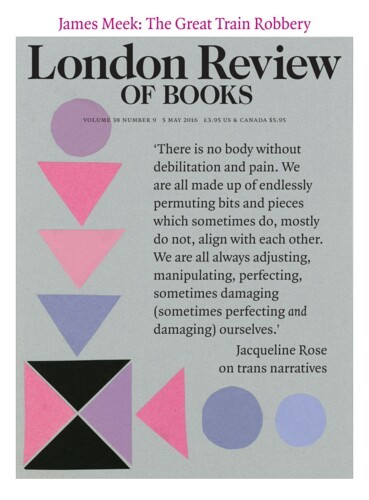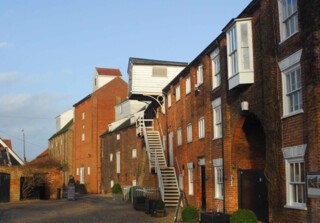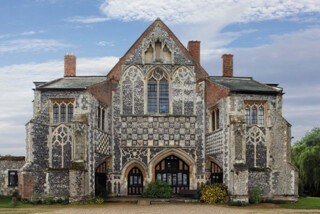Nikolaus Pevsner took an interest in cars. He considered them a form of industrial art. ‘It is only the taking of risks which makes life worth living,’ he said in the 1930s, maligning British car designers for their insufficient daring. But appreciation is one thing, driving another, and no matter how admiring or critical he was of cars and their design, Pevsner was always hopeless at the wheel. In her 2011 biography, Susie Harries says he failed his test so often that the driving school felt sufficiently guilty to discount its fee. In 1948, almost twenty years after he left Germany and arrived in Britain, he had another go and afterwards described it to his wife, Lola. ‘Tired, washed out, deflated, dizzy (only three whiskies), and not a bit happy. I made several really awful mistakes, turning in the street with brakes on … My only reaction at the moment is intense hatred against my car.’ That was how he relayed the news that he had passed his test. ‘Behind the wheel I am probably awful enough, and sometimes the gears tell me so … What wears me out is to think of so many things. I do sometimes drive with the brake on, for example. And always locking back doors, locking front door, buying bread, buying petrol, watching oil, etc, etc.’ There aren’t many drivers who admit to being that bad. So it was amazing that Pevsner would come up with an idea for a series of books that depended on driving: a county-by-county guide to the buildings of England. He found others to take the wheel, but there was a perversity in Pevsner’s choice.
He and his assistants would collate papers, documents and photographs on the buildings they were to visit before setting off on trips of six weeks or so, the boxes of research on the back seat, the car – there were a number of different models over the years – doubling up as the office. A caravan was eventually part of the set-up. ‘Work … has been a pleasure throughout,’ Pevsner wrote in the introduction to the first edition of Suffolk. ‘The weather was clement, the natives friendly, the scenery and the buildings a delight.’ Lola was at the wheel. ‘My wife did the driving on A-roads and farm tracks with ever equal and even skill and patience.’ The guides seem designed for two people: one reading from the book, the other taking in what’s being described as they look on. (Lola died in 1963; Pevsner’s later journeys were usually made with students from the Courtauld.)
The first edition of the Suffolk guide was published in 1961; it was revised in 1974, and has now been divided into east and west, the border the old Roman road – now the A140 – which heads north from Ipswich towards Norwich. James Bettley, who has already revised Essex, is responsible for the expansion. The Buildings of England series has left Penguin for Yale University Press, who have both overseen the third edition of the series and continued with the new volumes of Buildings of Scotland. In the stacks of the library at the Warburg Institute, in the topography section, are the three hardback editions of the Pevsner Suffolk guide. Once slim, pocketable and beige, the volumes are now black, thick, and less handy.
This may be the last print edition of the series. A digital version would expand the guides’ uses: and if you don’t have the right sort of imagination to visualise interiors or exteriors from written detail alone – I struggle – then virtual tours would help. You could zoom in on the detail described by the writing. Pevsner had hoped that his guides would eventually be used by every schoolchild in the country, but that was too ambitious: they’ve never sold as well as Pevsner and his publisher Allen Lane had hoped. One reason may be that Pevsner was too confident of his readers’ ability to reconstruct architectural reality in their imagination. In a sense, he knew it: ‘I have given you the facts,’ he said of Buildings of England. ’You must go and look at them and make up your own mind.’
The writing in the guides is to the point, and that’s been preserved in the new editions. Pevsner and Betjeman had a public feud about the language of architecture; exactness and detail v. mood and feeling. Betjeman wrote to Norman Scarfe to praise his ‘magnificent’ book on Suffolk’s landscape and its history, and each sentence is an attack on Pevsner. ‘You write beautifully. You inform without dehumanising. There is not a hint of art history, thank God, but love of the unexplored and mysterious county of Suffolk.’ There was little between Betjeman and Pevsner when it came to what they admired in English architecture – they preferred the low-key and an absence of grandeur. ‘Betjeman’s brand of evocation,’ Harries says, ‘is more about churchgoing than about the churches themselves, and tends to turn the focus on the observer as much as the object observed.’ Pevsner’s researches were more unrelenting, and if close observation reveals the mysteries of architecture, then Pevsner’s eye was the more searching. He’d seen more, and knew more.
Suffolk is the eighth largest county in England, but there is no big town – the London borough of Ealing has a larger population than Ipswich, Bury St Edmunds and Lowestoft put together. For centuries the county had no capital; Ipswich and Bury St Edmunds were legal and administrative centres; the county was part of the diocese of Norwich; its architecture is generally pre-Victorian; its scattered towns and villages reflect a region with a long history of decentralisation. Suffolk’s border with Norfolk is roughly ninety miles from London, but the county seems further away from the capital than that. ‘One of the chief attractions of Suffolk, perversely, is that it is not very easily accessible by road,’ Pevsner wrote. ‘The A12 is discouraging.’ On-the-way-to-nowhere is another of those hard-to-prove remarks often made about the county, but it isn’t true: the cargo port at Felixstowe is enormous, the connection with the rest of the world impossible to miss. There’s a myth that nothing much happens in Suffolk, or if it did then it happened a long time ago. ‘Very quiet here,’ Hardy wrote to his sister from Aldeburgh. ‘Whole town rather solitary,’ Carlyle said. (These details are lifted from Ronald Blythe’s The Time by the Sea: Aldeburgh 1955-58, an account of years spent with Benjamin Britten, Peter Pears and E.M. Forster on the east coast.) ‘I see by a handbill in the grocer’s shop that a man is going to lecture on the Gorilla in a few weeks,’ said Edward FitzGerald, who lived near Woodbridge. ‘So there is something to look forward to.’
‘Suffolk is supremely and unassailably isolated,’ Julian Tennyson wrote in Suffolk Scene. ‘It is a country for the individualist, for the explorer and lover of loneliness.’ Supremely and unassailably? ‘The modern landscape of Suffolk is still essentially a medieval one,’ Scarfe wrote in 1972 – he was referring to the size of its fields and woods, and how they related to villages and towns. In English Hours, Henry James wrote about the ‘old usual rural things’ he came across as he bicycled close to the east coast. ‘Part of the charm of one’s exposure to them is that they ask one to rise to no heroics. What is the charm, after all, but just the abyss of the familiar.’ Kenneth Clark, who grew up at Sudbourne Hall, a now demolished Wyatt house near Orford, said that what made the Dark Ages so dark was ‘the isolation, the lack of mobility, the lack of curiosity, the hopelessness’. The way some of its admirers talk about Suffolk, you wonder whether it ever emerged from the Dark Ages.
‘The county of Suffolk offers the nearest approach to an epitome of the Stone Age of man that is probably to be found in the whole world,’ according to the Victoria County History. Assessing the poetry of the Suffolk poet George Crabbe in The Spirit of the Age, Hazlitt wrote:
There are here no ornaments, no flights of fancy, no illusions of sentiment, no tinsel of words. His song is one sad reality, one unraised, unvaried note of unavailing woe. Literal fidelity serves him in the place of invention; he assumes importance by a number of petty details; he rivets attention by being tedious.
Forster admired Crabbe for seldom visiting London and for never going to Italy. Constable never went to Italy either, and tended to look down on those who were ‘mouldering away’ in the eternal city. No chance of that in Suffolk: ‘The sound of water escaping from mill dams, etc, willows, old rotten planks, slimy posts and brickwork – I love such things,’ he said.
‘Bleak’, ‘lonely’ and ‘melancholic’ may be ways to avoid the more obvious point: Suffolk is flat. ‘The landscape of Suffolk is not especially varied,’ Pevsner said. ‘Much of it can be summed up as rolling countryside.’ That’s generous. The area known as High Suffolk is never more than two hundred feet above sea level. Manmade buildings often stand out against a background of sky: belfries, spires, water towers, the BBC aerials at Orfordness, the derricks at Felixstowe, Sizewell B. The Financial Times not long ago described the nuclear power station as ‘magical’. The updated Buildings of England guide agrees:
Sizewell B was built in 1987-95, the country’s only commercial pressurised water reactor and designed to be productive for forty years. Here Yorke Rosenberg Mardall … created a building that, whatever one might feel about the placing of such an establishment in this location, has a magical quality … The white dome, which is the outer shell of the containment building that protects the reactor and its steam generator, is about 230 ft (70 metres) high and can be glimpsed from miles around.
Pevsner, admirer of Gropius and risk-taker that he was, had no obvious objection to nuclear power. He described the architecture of the Sellafield reprocessing plant as ‘blocky’. Others may be more ambivalent about the magic of Sizewell.
It’s only since the end of the Cold War and the departure of the US airforce in the early 1990s that eastern Suffolk has ceased to be a semi-militarised zone. In the Second World War the county was a launch pad for the destruction of Germany. From 1941 until the early 1990s, thousands of American airmen were stationed at Suffolk airbases. I remember in the 1970s and 1980s the low-flying American Phantoms and British Vulcans, practising for the nuclear battle ahead, when I was staying with my grandparents, near Halesworth.
The US base at Bentwaters, near Woodbridge, has been dismantled; there isn’t much left for the new edition of Buildings of England to report on. In Tony Palmer’s film Benjamin Britten and His Festival, an American officer describes Britten turning up to ask whether all the war practice could be halted for the Aldeburgh music festival. The festival is held in the concert hall at Snape, a former malthouse at the head of the Alde river, and one of the earliest examples in Britain of the transformation of an industrial building into an art space:
SNAPE MALTINGS. On the S side of the River Alde, in the parish of Tunstall. Their modern history starts in 1841 when Newson Garrett (cf. Aldeburgh) bought the business and set about expanding it. The result is an uncommonly impressive group of industrial buildings, and a prime example of what J.M. Richards of the Architectural Review called ‘the functional tradition’ … The works closed in 1965 and the large malthouse was converted to a Concert Hall for the Aldeburgh festival by Derek Sugden of Arup Associates, 1966-67. As a conversion it was a model of its kind. The character of the maltings were kept … The bricks of the walls are exposed and not dolled up.
The proportion of public to private buildings listed in the Suffolk volumes – and the rest of the BoE – is hard to gauge, but much of what you read about you can’t easily see. The gatehouse to what was once Butley Priory is one example. The guide doesn’t tell you that it can be rented: it sleeps 11 and costs £900 a night (the pictures on the priory’s website show interiors of light stone and white paint). The new edition preserves Pevsner’s original entry, one of the longest on a single building in Suffolk. The abbey was founded by the Augustinian monastic order in 1171, and was once the second most profitable religious house in the county after the Abbey of Bury St Edmunds.
What remains complete, or nearly complete, is only the gatehouse, and this is one of the most ambitious and interesting buildings of the C14 in Suffolk. It was built during the rule of prior William Geytone (1311-32). Its historical importance lies in the fact that the heraldry which is so lavishly displayed on it proves a date of c.1320 and that it is the earliest datable building with flushwork decoration in Suffolk … Nor is the decoration used in any way hesitatingly. On the contrary, stimulated by the general trend of these years, which was all for the greatest luxuriance and elaboration, the designer of the Butley gatehouse got at once as much decorative vivacity out of it as any of his successors ever after.
Ten years before Pevsner’s guide came out, A.G. Dickens, the historian of the Reformation, wrote that ‘Butley formed at no stage a remarkable centre of cultural activity.’ Pevsner clearly didn’t agree.
Pevsner is careful to include structures that have vanished: abbeys, airforce bases, country houses. For him there was no such thing as a ruin.
SUDBOURNE HALL. The house was demolished in 1951. Sir Michael Stanhope’s house had been rebuilt by James Wyatt for the 1st Marquess of Hertford, c.1784, a plain, stuccoed, three-storey affair, nine bays wide. Remodelled for Sir Richard Wallace (of the Wallace Collection), natural son of the 4th Marquess, 1872-73, probably by Thomas B. Ambler and again in 1906-7 by Fryers and Penman for K.M. Clark. What remains on the site is a 1920s red brick servants’ wing and to the W, the former stableyard.
Curiously, Kenneth Clark in his autobiography omits any association the house had with the founders of the Wallace Collection. But he does say he preferred the stables and servants’ quarters to the main house. ‘I was glad to leave the house and make my way to the stables. As so often in the early 19th century, they were better designed and constructed than the house.’ According to Harries, few people irritated and fascinated Pevsner more than Clark. Clark’s grace and ease with life outraged Pevsner, who bridled at the art-as-I-see-it connoisseurship. After listening to Clark lecture on Leonardo, he wrote to Lola:
The tenor of it is an arrogance for which I could box his ears. ‘Leonardo shouldn’t have done this,’ ‘that was a waste of time,’ and then the rather blasé jokes in between to make the students laugh … This gang just wants their own tastes their own style at any price, and put this before the work of art. There isn’t the real passion of our scholars … Will they accept the way I do it?
When Clark’s The Gothic Revival was published, Pevsner called it ‘elegant’, which wasn’t well meant: ‘There are many reasons of national character to account for the elegance of Sir Kenneth Clark’s Gothic Revival and the sketchiness of Mr Goodhart-Rendel’s English Architecture since the Regency as against the massive learning and relentless descriptiveness of Professor [Henry-Russell] Hitchcock.’ Clark never went out of his way to disguise himself: massive learning and relentless descriptiveness were beyond him, as he admitted in his autobiography. Lecturing and talking, he said, had ruined his concentration for scholarship of the kind Pevsner admired. Eventually, gradually, Pevsner became more enamoured of the man: Clark got things done.
Pevsner conceded that the strong focus on architecture had drawbacks. ‘I should now fill the rest of this page with nice human bits, but it’s no good,’ he wrote in a note to some of his collaborators after one of his final county tours. ‘The journeys just are not human.’ The exclusion of those ‘nice human bits’ makes sense – these are architectural guides. And it’s not as if the goings-on at Sudbourne Hall are hard to find. Clark’s autobiography brings the place to life. Sudbourne was an ancient estate: King Edgar gave the manor of Sudbourne to Bishop Aethelwold in 960; it was a gift of thanks for the cleric’s translation of the rules of St Benedict. Clark described the house as ‘one of Wyatt’s typical East Anglian jobs’: ‘a large, square, brick box, with a frigid neo-classical interior’. So frigid that Clark’s father, a Scot who inherited a textile fortune and bought the estate shortly after the birth of his only child, had its interior refurbished to resemble a Scottish baronial pile. He was ‘a broth of a man’ according to Clark. He sailed and won silver cups; in Suffolk, he bred prize-winning cattle, pigs and horses, and won more silver. Clark said that his sense of physical form developed from his observations of the Suffolk Punches bred at the Sudbourne stud.
The Clarks had their friends and cronies, but they were less out to impress than to overwhelm them. In 1905, Sudbourne had one of the largest lawns on the planet: the previous owners, who had acquired the house and estate from Richard Wallace, had steam-driven lawn mowers specially made to cut it. In Clark’s day, there was a golf course, and a professional player was retained by his father so that visiting friends could improve themselves. His father never played, although he enjoyed driving balls over the roof of the house. His guests weren’t so good at it, clattering balls against Wyatt’s brick box, or smashing the windows. Shooting was the main attraction. The Clarks and their friends shot thousands of pheasant on an ordinary day – and the shooting carried on after the start of the First World War. ‘My parents arrived from Scotland in time for the first of October, when pheasant shooting began, and left for Monte Carlo on the tenth of January, when all but the wiliest of old birds had been polished off.’ On the Riviera, Clark senior broke the bank more than once.
It didn’t last. Clark’s father turned sour; there were no longer the men to run such an estate. It was a colossal folly. The house was sold to a soap magnate who kept it going for some years: in the Second World War it was requisitioned by the army. As an English Heritage pamphlet on Suffolk’s coastal defences says, the 11,000-acre estate was the training ground for the British invasion of Normandy; a volley of incoming shells fired from ships offshore to simulate the battle conditions troops could expect on the French beaches missed their target and blew up part of south Aldeburgh. Beyond repair, the house was torn down in 1951 – the year in which the first of the Buildings of England series was published. As the east Suffolk volume points out, all that remains of Sudbourne Hall are the stables and outhouses, which have been converted into flats.
Send Letters To:
The Editor
London Review of Books,
28 Little Russell Street
London, WC1A 2HN
letters@lrb.co.uk
Please include name, address, and a telephone number.




